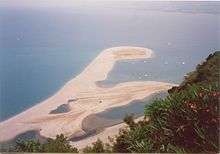Tindari
Tindari is a district ( fraction ) of the municipality Patti in the metropolitan city of Messina in the Sicily region in Italy . Here are excavations of the ancient city of Tyndaris and a pilgrimage church.
Location and dates
Tindari is located in the municipality of Patti . It is located on the Capo Tindari Mountains on the Tyrrhenian Sea .
history
The area was already inhabited in the Sicilian Bronze Age. The layers from the 17th to 15th centuries BC Ceramics brought to light in BC are typical of the Rodì-Tindari-Vallelunga facies named after this site . Tyndaris was born in 396 BC. Founded by Dionysius I of Syracuse . During the Punic Wars , the city allied itself with the Romans. In the 1st century, part of the city disappeared into the sea due to an earthquake.
In ancient times, Tindari was the seat of a bishopric, which is what today's titular bishopric of Tyndaris goes back to.
The city was destroyed by the Arabs in 836. Today's settlement was built in 1094. The city was destroyed during the Sicilian Vespers (1282). The city was rebuilt and again destroyed by pirates.
Attractions
Pilgrimage Church with the Black Madonna
The Black Madonna of Tindari is venerated in the Roman Catholic pilgrimage church built in the 1950s .
According to tradition, the miraculous image of the Santuario came in the 8th / 9th centuries. Century from Constantinople , where the iconoclasm had broken out, to Sicily.
According to legend, the portrait was washed ashore in a box. The image of grace bears the inscription NIGRA SUM SED FORMOSA (German: “I am black, but beautiful”). The picture is festively decorated for the feast of the birth of Mary on September 8th.
The pilgrimage church was built around a smaller, older church. It can still be viewed today. There is also the black Madonna.
From the forecourt of the pilgrimage church you can see the natural spectacle of the mare secco , an elongated sandbank protruding into the sea. You also have a far-reaching view of the rocks of Tindari, the hinterland of Milazzo and the Aeolian Islands .
Ancient Tyndaris
The excavations began in 1812. Since then, part of the ancient Tyndaris has been exposed. No excavations took place under the pilgrimage church.
The finds include:
- Remains of the city wall
- a basilica
- Antiquarium
- a Greek theater
Legend of the Black Madonna
As a popular explanation for the natural phenomenon of the mare secco , the following legend is told: A small child fell from the mountain into the water. The mother, a pilgrim, prayed to the holy Mother of God in her need. A hand rose from the sea and the child was saved.
The shape of the sandbar in the lagoon of Tindari can be interpreted as an arm with a hand stretched out from the island.
Coordinates: 38 ° 9 ' N , 15 ° 2' E
literature
- Michele Fasolo, Tyndaris e il suo territorio I. Introduzione alla carta archeologica del territorio di Tindari , Roma 2013, ISBN 978-88-908755-1-9 .
- Michele Fasolo, Tyndaris e il suo territorio II. Carta archeologica del territorio di Tindari e materiali , Roma 2014, ISBN 978-88-908755-2-6 .



